10.8: Reproductive Behavior
- Page ID
- 12246
\( \newcommand{\vecs}[1]{\overset { \scriptstyle \rightharpoonup} {\mathbf{#1}} } \)
\( \newcommand{\vecd}[1]{\overset{-\!-\!\rightharpoonup}{\vphantom{a}\smash {#1}}} \)
\( \newcommand{\dsum}{\displaystyle\sum\limits} \)
\( \newcommand{\dint}{\displaystyle\int\limits} \)
\( \newcommand{\dlim}{\displaystyle\lim\limits} \)
\( \newcommand{\id}{\mathrm{id}}\) \( \newcommand{\Span}{\mathrm{span}}\)
( \newcommand{\kernel}{\mathrm{null}\,}\) \( \newcommand{\range}{\mathrm{range}\,}\)
\( \newcommand{\RealPart}{\mathrm{Re}}\) \( \newcommand{\ImaginaryPart}{\mathrm{Im}}\)
\( \newcommand{\Argument}{\mathrm{Arg}}\) \( \newcommand{\norm}[1]{\| #1 \|}\)
\( \newcommand{\inner}[2]{\langle #1, #2 \rangle}\)
\( \newcommand{\Span}{\mathrm{span}}\)
\( \newcommand{\id}{\mathrm{id}}\)
\( \newcommand{\Span}{\mathrm{span}}\)
\( \newcommand{\kernel}{\mathrm{null}\,}\)
\( \newcommand{\range}{\mathrm{range}\,}\)
\( \newcommand{\RealPart}{\mathrm{Re}}\)
\( \newcommand{\ImaginaryPart}{\mathrm{Im}}\)
\( \newcommand{\Argument}{\mathrm{Arg}}\)
\( \newcommand{\norm}[1]{\| #1 \|}\)
\( \newcommand{\inner}[2]{\langle #1, #2 \rangle}\)
\( \newcommand{\Span}{\mathrm{span}}\) \( \newcommand{\AA}{\unicode[.8,0]{x212B}}\)
\( \newcommand{\vectorA}[1]{\vec{#1}} % arrow\)
\( \newcommand{\vectorAt}[1]{\vec{\text{#1}}} % arrow\)
\( \newcommand{\vectorB}[1]{\overset { \scriptstyle \rightharpoonup} {\mathbf{#1}} } \)
\( \newcommand{\vectorC}[1]{\textbf{#1}} \)
\( \newcommand{\vectorD}[1]{\overrightarrow{#1}} \)
\( \newcommand{\vectorDt}[1]{\overrightarrow{\text{#1}}} \)
\( \newcommand{\vectE}[1]{\overset{-\!-\!\rightharpoonup}{\vphantom{a}\smash{\mathbf {#1}}}} \)
\( \newcommand{\vecs}[1]{\overset { \scriptstyle \rightharpoonup} {\mathbf{#1}} } \)
\( \newcommand{\vecd}[1]{\overset{-\!-\!\rightharpoonup}{\vphantom{a}\smash {#1}}} \)
\(\newcommand{\avec}{\mathbf a}\) \(\newcommand{\bvec}{\mathbf b}\) \(\newcommand{\cvec}{\mathbf c}\) \(\newcommand{\dvec}{\mathbf d}\) \(\newcommand{\dtil}{\widetilde{\mathbf d}}\) \(\newcommand{\evec}{\mathbf e}\) \(\newcommand{\fvec}{\mathbf f}\) \(\newcommand{\nvec}{\mathbf n}\) \(\newcommand{\pvec}{\mathbf p}\) \(\newcommand{\qvec}{\mathbf q}\) \(\newcommand{\svec}{\mathbf s}\) \(\newcommand{\tvec}{\mathbf t}\) \(\newcommand{\uvec}{\mathbf u}\) \(\newcommand{\vvec}{\mathbf v}\) \(\newcommand{\wvec}{\mathbf w}\) \(\newcommand{\xvec}{\mathbf x}\) \(\newcommand{\yvec}{\mathbf y}\) \(\newcommand{\zvec}{\mathbf z}\) \(\newcommand{\rvec}{\mathbf r}\) \(\newcommand{\mvec}{\mathbf m}\) \(\newcommand{\zerovec}{\mathbf 0}\) \(\newcommand{\onevec}{\mathbf 1}\) \(\newcommand{\real}{\mathbb R}\) \(\newcommand{\twovec}[2]{\left[\begin{array}{r}#1 \\ #2 \end{array}\right]}\) \(\newcommand{\ctwovec}[2]{\left[\begin{array}{c}#1 \\ #2 \end{array}\right]}\) \(\newcommand{\threevec}[3]{\left[\begin{array}{r}#1 \\ #2 \\ #3 \end{array}\right]}\) \(\newcommand{\cthreevec}[3]{\left[\begin{array}{c}#1 \\ #2 \\ #3 \end{array}\right]}\) \(\newcommand{\fourvec}[4]{\left[\begin{array}{r}#1 \\ #2 \\ #3 \\ #4 \end{array}\right]}\) \(\newcommand{\cfourvec}[4]{\left[\begin{array}{c}#1 \\ #2 \\ #3 \\ #4 \end{array}\right]}\) \(\newcommand{\fivevec}[5]{\left[\begin{array}{r}#1 \\ #2 \\ #3 \\ #4 \\ #5 \\ \end{array}\right]}\) \(\newcommand{\cfivevec}[5]{\left[\begin{array}{c}#1 \\ #2 \\ #3 \\ #4 \\ #5 \\ \end{array}\right]}\) \(\newcommand{\mattwo}[4]{\left[\begin{array}{rr}#1 \amp #2 \\ #3 \amp #4 \\ \end{array}\right]}\) \(\newcommand{\laspan}[1]{\text{Span}\{#1\}}\) \(\newcommand{\bcal}{\cal B}\) \(\newcommand{\ccal}{\cal C}\) \(\newcommand{\scal}{\cal S}\) \(\newcommand{\wcal}{\cal W}\) \(\newcommand{\ecal}{\cal E}\) \(\newcommand{\coords}[2]{\left\{#1\right\}_{#2}}\) \(\newcommand{\gray}[1]{\color{gray}{#1}}\) \(\newcommand{\lgray}[1]{\color{lightgray}{#1}}\) \(\newcommand{\rank}{\operatorname{rank}}\) \(\newcommand{\row}{\text{Row}}\) \(\newcommand{\col}{\text{Col}}\) \(\renewcommand{\row}{\text{Row}}\) \(\newcommand{\nul}{\text{Nul}}\) \(\newcommand{\var}{\text{Var}}\) \(\newcommand{\corr}{\text{corr}}\) \(\newcommand{\len}[1]{\left|#1\right|}\) \(\newcommand{\bbar}{\overline{\bvec}}\) \(\newcommand{\bhat}{\widehat{\bvec}}\) \(\newcommand{\bperp}{\bvec^\perp}\) \(\newcommand{\xhat}{\widehat{\xvec}}\) \(\newcommand{\vhat}{\widehat{\vvec}}\) \(\newcommand{\uhat}{\widehat{\uvec}}\) \(\newcommand{\what}{\widehat{\wvec}}\) \(\newcommand{\Sighat}{\widehat{\Sigma}}\) \(\newcommand{\lt}{<}\) \(\newcommand{\gt}{>}\) \(\newcommand{\amp}{&}\) \(\definecolor{fillinmathshade}{gray}{0.9}\)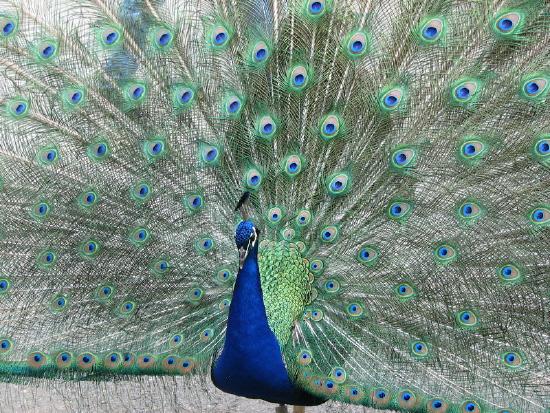
So when does the peacock extend his tail?
Peafowl are best known for the male's extravagant tail. Obviously though, a peacock cannot have his tail extended continuously. It would make it very difficult to move around. And it may be very tiring. So when does the peacock extend his tail? The peacock displays his tail as part of courtship.
Mating and Courtship
Mating refers to the union of a male and female of the same species for reproduction. The relationship between mates varies by species. Adults may have many mates, or they may mate with just one individual. Mates may stay together only while mating, for an entire breeding season, or even for life.
Females are likely to be more selective than males in choosing mates. In many species, males put on courtship displays to encourage females to choose them as mates. For example, to attract a mate, a male bowerbird builds an elaborate nest decorated with hundreds of small blue objects (see Figure below).
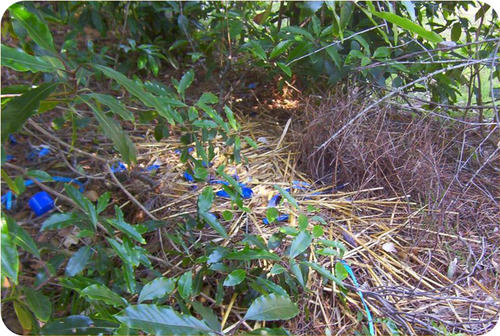 Bowerbird Decorating His Nest. A male bowerbird spends many hours collecting bits of blue glass and other small blue objects to decorate his nest. A female bowerbird inspects the nests of many males before choosing as a mate the male with the best nest.
Bowerbird Decorating His Nest. A male bowerbird spends many hours collecting bits of blue glass and other small blue objects to decorate his nest. A female bowerbird inspects the nests of many males before choosing as a mate the male with the best nest.Parental Care
In most species of fish, amphibians, and reptiles, parents provide no care to their offspring. In birds and mammals, on the other hand, parental care is common. Most often, the mother provides the care. However, in some species, both parents or just the father may be involved.
Parental care is generally longest and most involved in mammals. Besides feeding and protecting their offspring, parents may teach their offspring skills they will need to survive on their own. For example, meerkat adults teach their pups how to eat scorpions. They show the pups how to safely handle the poisonous insects and how to remove the stingers.
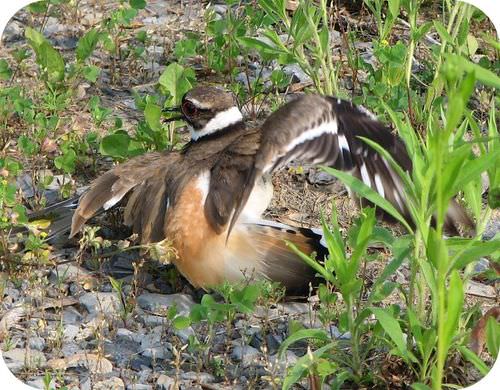 This mother killdeer is pretending she has a broken wing. She is trying to attract a predator’s attention in order to protect her chicks. This behavior puts her at risk of harm. How can it increase her fitness?
This mother killdeer is pretending she has a broken wing. She is trying to attract a predator’s attention in order to protect her chicks. This behavior puts her at risk of harm. How can it increase her fitness?Defending Territory
Some species of animals are territorial. This means that they defend their area. The area they defend usually contains their nest and enough food for themselves and their offspring. A species is more likely to be territorial if there is not very much food in their area. Animals generally do not defend their territory by fighting. Instead, they are more likely to use display behavior. The behavior tells other animals to stay away. It gets the message across without the need for fighting. Display behavior is generally safer and uses less energy than fighting. Male gorillas use display behavior to defend their territory. They pound on their chests and thump the ground with their hands to warn other male gorillas to keep away from their area. The robin displays his red breast to warn other robins to stay away (Figure below).
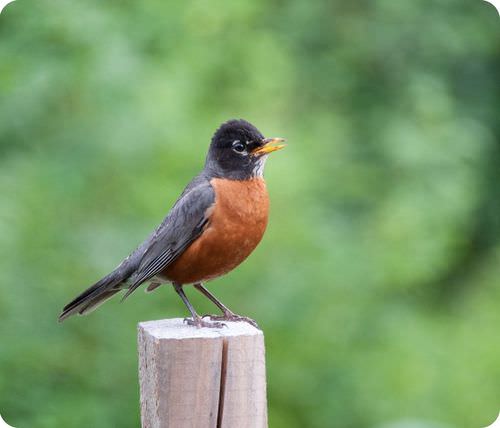 The red breast of this male robin is easy to see. The robin displays his bright red chest to defend his territory. It warns other robins to keep out of his area.
The red breast of this male robin is easy to see. The robin displays his bright red chest to defend his territory. It warns other robins to keep out of his area.Some animals deposit chemicals to mark the boundary of their territory. This is why dogs urinate on fire hydrants and other objects. Cats may also mark their territory by depositing chemicals. They have scent glands in their face. They deposit chemicals by rubbing their face against objects.
Science Friday: "Hot" For Turkey
A male wild turkey's display conjures images of Americana and festive feasts, but isn't intended for human eyes. In this video by Science Friday, Dr. Richard Buchholz describes how female turkeys use it to discern a male's genetic prowess.
Science Friday: Shake Your Silk-Maker: The Dance of the Peacock Spider
With their ornately-colored bodies, rhythmic pulsations, and booty-shaking dance moves, male peacock spiders attract the attention of spectating females as well as researchers. In this video by Science Friday, researcher Madeline Girard interprets what these displays actually say to a female spider.
Science Friday:In A Flash: Firefly Communication
Fireflies communicate with a "language of light" that scientists still don't completely understand. In this video by Science Friday, researchers James Lloyd and Marc Branham discuss unique flash patterns and times for some of the 2,000 types of fireflies that light up the summer nights.
Summary
- Behaviors relating to reproduction include mating, courtship, and parenting behaviors.
Review
- Describe an example of courtship behavior in animals.
- In what vertebrates is parental care common?
- Give two examples of parental care.
| Image | Reference | Attributions |
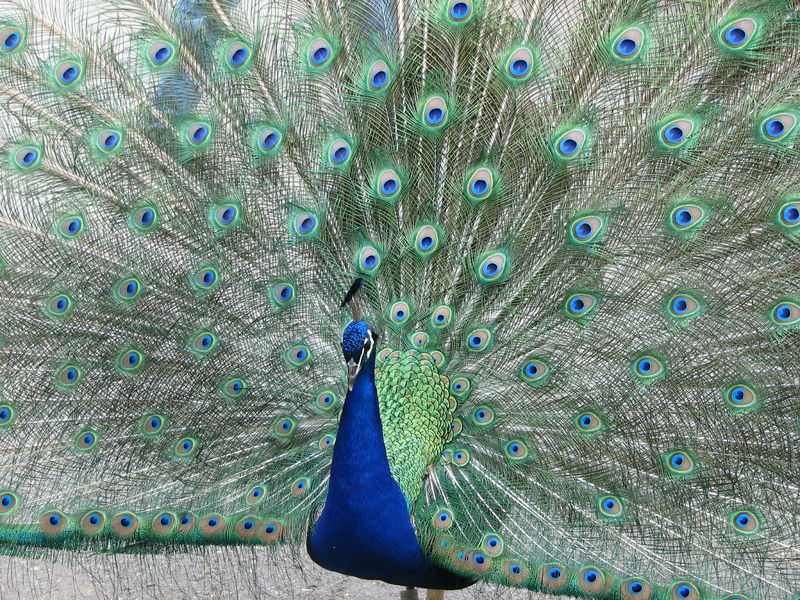 |
[Figure 1] | Credit: Dwight Sipler Source: http://www.flickr.com/photos/photofarmer/5899245104/ License: CC BY 2.0 |
 |
[Figure 2] | Credit: User:Dfrg.msc/Wikipedia Source: commons.wikimedia.org/wiki/File:BBNest.jpg License: CC BY 2.5 |
 |
[Figure 3] | Credit: audreyjm529 Source: http://www.flickr.com/photos/98799884@N00/3567167561/ License: CC BY 2.0 |
 |
[Figure 4] | Credit: Dwight Sipler Source: http://www.flickr.com/photos/photofarmer/5899245104/ License: CC BY 2.0 |

